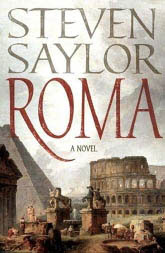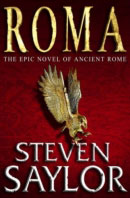|
Steven says: “This book marks a departure from my Roma Sub Rosa series. I wanted to try my hand at a truly epic novel, and to explore the remarkable ten centuries that came before the time of Gladiator, HBO’s Rome, and my own books. This is the story of how the Romans created the greatest city on earth — the story of how Rome became Rome.”
|
 |
|
An interview with
Steven Saylor about
ROMA
The Novel of Ancient Rome
What was it like to do the research for such a big project?
Sheer pleasure. When you dive into the research required for a historical novel written on this scale, it’s tremendously exciting; whole new worlds unfold as you follow one fascinating link to another, going further and further back in time to unravel the story of Rome’s origins.
The research was anything but dull, because the ancient historians had a keen sense of storytelling. They wanted to keep their audience enthralled from first page to last, so the accounts they’ve given us are full of all the “good stuff” — tales of heroism and treachery, rape and revenge, hope and heartbreak. The people who built Rome into the greatest city on earth — warlords, slaves, Vestal virgins, rabble-rousing politicians, scheming millionaires — still live for us today because the human drama of their lives still touches us.
How did you move beyond the research into the actual writing?
Creating the novel presented a great challenge, given the immense sweep (a span of a thousand years), the sheer number of characters, and the huge historical and political issues involved. I chose to split the big story into a number of smaller stories set a few generations apart, linked across the centuries by following the fortunes of two of the founding families of Rome. Their personal dramas allowed me to hit the very highest points of the historical saga, episodes such as the sack of Rome by the Gauls — a humiliation the Romans never forgot or forgave — and the terrifying threat the Romans faced when Hannibal crossed the Alps with his elephants, determined to destroy Rome forever. There are several critical points when Rome might have been wiped from the face of the earth and forgotten, but thanks to the gods, and the sheer determination of her citizens, Rome always survives.
We first see the site of Rome as nothing more than a stop on a trade route, but by the end of the book it’s become the world’s biggest and most powerful city. How did that happen?
Relentless military conquest was always the key to Rome’s success, but so was Roman innovation. It was a man named Appius Claudius who gave Rome the world’s first aqueduct, the Aqua Appia; without water from distant sources, Rome could never have grown to accommodate a million inhabitants. He also laid down the famous Appian Way, which revolutionized road building. Roman roads not only allowed armies to march across Europe, they also allowed the wealth of conquered lands (including slaves) to be brought back to the capital. Those ancient roads were so finely built that they still exist all over Europe today.
As Rome grows richer and more powerful, Roman culture becomes more sophisticated. We see the birth of the Roman theater, for example, and the importation of foreign artists and sculptors to decorate the magnificent temples that will make Rome the most opulent city on earth. As their sphere of influence expands, the Romans also begin to import exotic religions, including the infamous Cult of Bacchus, which included orgiastic rituals, and the worship of Cybele, whose priests castrated themselves. The more religiously conservative Romans begin to think the city needs a thorough cleansing, and the result is one of history’s bloodiest witch-hunts.
The details about Roman religion are eye-opening. You’re also clearly fascinated by the politics of ancient Rome.
Endlessly fascinated, because they’re still so relevant today. Rome moves from a small community of traders to a walled city ruled by kings. Then, after driving off a particularly nasty king called Tarquin — the famous rape of Lucretia causes his downfall — the upper classes establish a new form of elected government they call a republic. The kings tended to balance the interests of the have-nots against the power of the rich, but in the new republic, it’s every man for himself. The elite class, the patricians, ruthlessly stack the electoral process to favor themselves, but the unruly have-nots, the plebeians, have their own hand to play — they’re needed to harvest crops and fill the ranks of the army — so there’s a constant tug of war between the classes.
All the issues Americans deal with today in our polarized republic, the Romans dealt with first. Conservative politicians preached patriotism and religious piety and whipped up xenophobic hysteria; over and over we hear them say, “Do as your betters tell you and Rome will be safe; disobey us and your treason and sinfulness will let outsiders destroy Rome.” At the other end of the political spectrum, rabble-rousers — whether driven by idealism or personal ambition — exploited the resentment of the struggling classes. Both sides used lawsuits and sexual scandals to drag down their opponents. Doesn’t all this sound familiar?
Yet, despite all that turmoil, the Roman Republic managed to last for almost 500 years. Why did it finally fail?
It was the imperial success of the Republic that doomed it. The staggering wealth brought in by foreign conquests only served to increase social and economic inequality — the poor became poorer, the rich became super-rich. And at the very top, a handful of men (like Caesar) became far too powerful. The social order was fractured and destabilized to the point of civil war, and when the wars were over, Rome essentially had a king again, the emperor Augustus. The Republic was dead, never to rise again.
The American republic has so far lasted only about half as long as did Rome’s. Whether it will end with the rise of an all-powerful executive, as happened in Rome, remains to be seen. There are certainly forces at work leading us in that direction.
What sort of characters populate the book?
I wanted Rome itself to be the leading character of the book, which is why I’ve tried to include the full sweep of the city’s history. But it’s the people of a city we care about, and I’ve tried to show these momentous events through the eyes of the men and women who actually experienced them.
Perhaps my favorite character is the Vestal virgin Pinaria, who becomes trapped along with a handful of defenders atop the Capitoline Hill when the Gauls conquer the city. Like all the Vestals, who came from leading families, Pinaria has led a very privileged, sheltered existence, and her values are completely proper and pious. But in a world turned upside-down, this Vestal virgin finds herself falling in love with a slave — something utterly unthinkable! — and she faces some wrenching choices.
You also include Romulus and Remus, the founders of the city. Were the twins real, or just legendary?
No one can say for sure. Modern historians used to dismiss the twins as mere legends, but that attitude has begun to change in recent years, thanks to new archaeological discoveries in Rome that date almost exactly to the supposed era of Romulus and Remus. More and more, it appears that the basic details given to us by the ancient sources are accurate, after all.
For all the regal trappings that Romulus took on in his later years, he and his brother essentially started out as ruthless young gang leaders who raided the countryside until they eliminated all the competition. They issued an open invitation to every brigand in Italy to come join them — which is how Rome ended up with too many men and not enough women, leading to the rape (i.e., abduction) of the neighboring Sabine women. Putting up walls around the settlement of Rome — making it a proper city — was just a way to protect their loot. When you read between the lines, the story of Romulus the founder is more gritty than glorious; it has the ring of truth.
You also tell the story of Coriolanus. His name is familiar...
That’s because Shakespeare wrote a tragedy about Coriolanus — T.S.Eliot declared it a greater play than “Hamlet.” As I researched the story, I saw what drew Shakespeare to such dramatic material. In the first years of the Republic, Rome’s greatest war hero is driven to become a traitor, then marches on Rome at the head of an invincible army. Only one force on earth can stop him and save the city. The story of Coriolanus provides one of history’s great twist endings.
Who else is in the book?
One of the characters commits one of history’s first mass murders — I don’t want to give away any details, but I promise they come straight from the historical record.
Another character becomes the impresario for the first great Roman playwright, Plautus; he’s also hopelessly infatuated with his boyhood friend, who happens to become the greatest of all Roman generals, Scipio Africanus, the conqueror of Hannibal.
Then there are the brothers Tiberius and Gaius Gracchus, charismatic politicians who fearlessly try to revolutionize Roman society from the bottom up — and who meet a tragic fate that may remind readers of two Irish-American brothers named Kennedy.
The last descendent in the bloodline traced by ROMA is Lucius Pinarius, one of the three heirs named in the will of Julius Caesar. As the Republic ends and the age of the emperors begins, Lucius faces a very personal test of loyalty. Should he bow to the inevitable triumph of his despised cousin Augustus, or remain faithful to his friends, the doomed lovers Antony and Cleopatra?
There’s a gold talisman on a necklace — an image of a god called Fascinus — that’s handed down through the generations in ROMA, linking the first characters and all their descendents. Some readers may find this talisman a bit far-fetched.
And yet, the worship of Fascinus is one of the most authentic details in the book. The form taken by this god may indeed strike readers as unusual: Fascinus appears to the worshipper as a detached human phallus levitating in a fire, and the talisman worn by the characters is a gold image of a winged phallus.
Anyone who’s been to Pompeii has seen phallic images on buildings, and museums have many examples of such amulets. To the ancients, these images weren’t prurient or even sexual; they represented the god Fascinus, who protected wearers from the so-called “evil eye” or “fascination” (the word comes from Fascinus). The Vestal virgins placed such an image beneath the chariot of a general when he celebrated a triumph, and phallic trinkets were widely worn, especially by women in childbirth and by infants.
Fascinus is significant because the ancestors of the Romans had no gods in the strict sense; they believed in tree-spirits and such, and only later adopted the gods of others, especially the Greeks. But the very first deity of the Roman ancestors, uniquely native to Rome, may have been Fascinus, who appears in their earliest myths. That’s why I put Fascinus at the heart of ROMA — though by the end of the book, the god’s talisman, worn by time, has subtly changed shape, setting the stage for a new millenium and a new era of the Eternal City.
|




